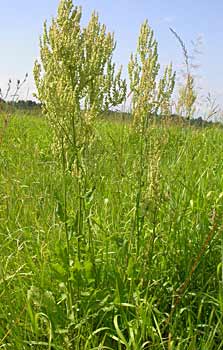Relatives
Rumex thyrsiflorus Fingerh. - Pyramidal sorrel
Taxonomic position.
Family Polygonacea Juss., genus Rumex L.Synonyms:
Acetosa thyrsiflora (Fingerh.) A. & D. Love; R. acetosa. subsp. thyrsiflorus (Fingerh.) Hayek.Morphology and biology.
This is a perennial plant with a powerful long, sometimes branching root. The stem is straight, naked, with deep grooves, 50-100 cm tall. Leaves are 3-13 cm long, 1.5-4 cm wide, ovare-oblong or lanceolate, narrowed at the top, sagittate at the base, naked, rarely villously pubescent. Lobes at the base of leaves are sharp, narrow, rejected outside. The plates of the leaves have a fine wavy margin on the edge. Radical and bottom stem leaves have long ridge pubescent stalks. The top leaves have short stalks, or sedentary, narrower and finer then radical ones. The inflorescence is a dense pyramidal panicle. Bracteoles are filmy, 1-3-dentate. Internal shares of perianth at fruits are wide-ovare, slightly jagged on its edges (slightly learned by rote) and narrow at the top, mesh, with a deep heart-shaped base, 3-4 mm long. Fruits are nutlets, trihedral, dark and brilliant. Blossoms in June-July, fructifies in July-August.Distribution.
The general distribution: Scandinavia, Average Europe, the Balkans, Asia Minor. In territory of the former USSR: the European part - all areas; Siberia - all areas; the Far East - Zeya - Bureinsky area (seldom).Ecology.
It grows in meadows, in marshes, on grassy slopes, breakages, on sandy, lime soils, on shingles.Use and economic value.
Leaves contain many vitamins, in roots up to 20% tannins. In China it is used as a fodder plant for pigs.Reference citations:
Brezhnev D.D., Korovina O.N. 1981. Wild relatives of cultivated plants of flora of USSR. Leningrad: Kolos. 123 p. (In Russian)Cherepanov S.K. 1995. Plantae Vasculares Rossicae et Civitatum Collimitanearum (in limics USSR olim)[List of Vascular Plants of Russia]. St. Petersburg: Mir I Semia. 990 pp. (In Russian)
Kharkevitch S.S., ed. 1989. Vascular plants of the Soviet Far East. V. 4. Leningrad: Nauka. 50-51 p. (In Russian)
Komarov, V.L., ed. 1939. Flora USSR. V. 5. Moscow-Leningrad: Publishing House of Acad. Science. 451-452 p. (In Russian)
Krasnoborov, I.M. & L.I. Malyshev, ed. 1992. Flora of the Siberia. V. 5. Salicaceae-Amaranthaceae. Novosibirsk: Nauka. V. 5. 247 p. (In Russian)
Malyshev, L.I. & G.A. Peshkova, ed. 1979. Flora of the Central Siberia. V. 1. Novosibirsk: Nauka. 280 p. (In Russian)
Vulf E.V., Maleeva O.F. 1969. The world resources of the useful plants. Leningrad: Nauka. 137 p. (In Russian)


